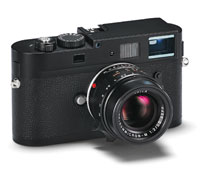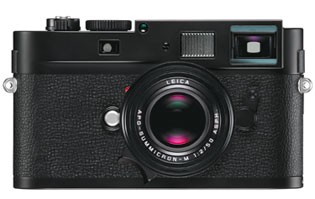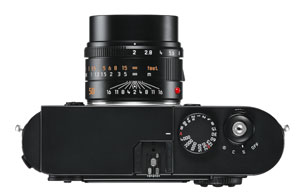The Leica M Monochrom: Is Leica Pricing Out Its Loyal Customers with an $8,000 Black-and-White Camera?
posted Wednesday, May 16, 2012 at 2:19 PM EDT
 Leica has gotten a lot of press in the last few days between the record-breaking auction of a 1923 Series-0 camera for nearly $3 million, to the announcement of a digital rangefinder that shoots only in black and white: the 18-megapixel Leica M Monochrom ($7,950).
Leica has gotten a lot of press in the last few days between the record-breaking auction of a 1923 Series-0 camera for nearly $3 million, to the announcement of a digital rangefinder that shoots only in black and white: the 18-megapixel Leica M Monochrom ($7,950).
Reading these reports including what we’ve written here on Imaging Resource, I must admit my initial reaction was bafflement, followed by sadness. I tried to understand these feelings, wondering why I felt anything at all about the sale of an old camera or a black-and-white-only digital camera?
However, in thinking about this, I realized just how important a role Leica has played in my life, starting from when I got involved in photography thirty years ago.
My first Leica was a IIc with a collapsible screw thread 50mm f/2 Summitar lens. It cost about $125 (in the 1970s) and it was, for a young photographer, a dream machine.
The Summitar image was a little creamy soft wide open but became razor sharp when stopped down. The IIc body had a solid feel and when I pressed the shutter release, it made a soft "pfft" sound. It was inconspicuous, handled easily and I quickly bonded with this little camera. We lived together on the streets of New York throughout my college years.
Later, I owned many other Leica bodies: an M2, M3, M4, M6, and my favorite, a compact Leica CL from 1974.
Band of Brothers
 Shooting Leica, I was part of a small band of brothers who stalked the mean streets of cities and the backwaters of remote jungles. We were different from the SLR people with their noisy clattering machines and gargantuan lenses.
Shooting Leica, I was part of a small band of brothers who stalked the mean streets of cities and the backwaters of remote jungles. We were different from the SLR people with their noisy clattering machines and gargantuan lenses.
While we quietly observed the world and visualized images in our minds before we shot, the SLR people were the loud crowd; insensitive louts gawking at the world through tubes and blasting away with motor drives. Admittedly, I used SLRs in my commercial work but it was a point of honor to have and prefer Leica for my "own imagery."
Years later, when I exhibited photos in Perpignan, France (2003) during the annual "Visa for the Photo" festival, I met a group of German photojournalism students. They were there with their instructor, exhibiting their class project photos documenting the lives of mayors in tiny villages across Germany. These students were young and very excited about photography.
I was touched by their enthusiasm and love of image making. They spoke excitedly about their futures and several said all they needed in the world was a Leica, a couple of lenses and a pocketful of film. With that they’d be off to photograph a sheepherder in Mongolia, a midwife in Amazonia, or a group of urban Roms (gypsies) in Albania.
For these kids, photography was what it had been for me: a journey of wonder and delight and at its spiritual heart was the Leica camera.
Back in 2003, a good used Leica M4 or M6 and a couple of lenses, cost perhaps $2,000. While that was a lot of money for these kids, it was something they could save for and earn while working odd jobs.
Enter Monochrom
 While I was thinking about this, I got an email from a Leica website. They asked me to participate in a survey about the new M Monochrom, which I did. The survey asked us Leicaphiles for our opinion of the Monochrom. To my amazement, nearly half of the over 1,200 respondents thought the camera was just too expensive and about 35% said that there was nothing in the camera for them or that it was just a weird idea. Only about 140 respondents (12.3%) were interested in the camera and thinking about buying it.
While I was thinking about this, I got an email from a Leica website. They asked me to participate in a survey about the new M Monochrom, which I did. The survey asked us Leicaphiles for our opinion of the Monochrom. To my amazement, nearly half of the over 1,200 respondents thought the camera was just too expensive and about 35% said that there was nothing in the camera for them or that it was just a weird idea. Only about 140 respondents (12.3%) were interested in the camera and thinking about buying it.
These numbers helped me understand my response to the M Monochrom and the auction sale of the Series-0. I was experiencing a shared sense of loss as "my" Leica company. I can understand Leica wanting to make money, especially after hemorrhaging cash for so long, but in my thinking they have turned their backs on the very photographers who made them successful.
Leica’s fame was built on the work and celebrity of Henri Cartier-Bresson. However, I cannot imagine it would please HCB to see the "luxe" direction Leica is taking. Bresson believed in the power of photography. Before his death, he created a photographic center in Paris to encourage and exhibit the work of photographers, mostly Leica photographers. If he were alive today, I have to believe he would urge Leica to invest a little more in the future of cameras as "working tools" rather than in the future of cameras as "investments."
The decision to make the M Monochrom particularly puzzled me for it seemed to target an almost impossibly small number of photographers. After all, how many photographers shoot only in black-and-white and how many of those can afford this camera? Moreover, the photographers I know who shoot black-and-white and make big exhibition prints still generally prefer to use black-and-white film and medium or large format cameras. So who was this camera aimed at and what was his or her name?
Ultimately, I really do not care if Leica wants to produce $8,000 cameras and $5,000 lenses for a few wealthy people. Like the 47% of the survey respondents, I can’t afford those prices. And that makes me wish that Leica would pay as much attention to the needs of other photographers, like a generation of young photographers who do not have $20,000 for a camera to take into a ghetto, or a jungle, or a combat zone.
Nevertheless, through it all, Leica is in my blood and part of my being. So as Leica turns away from we who love it, I have to ask, much as Julius Caesar did, “Et tu Leica?”